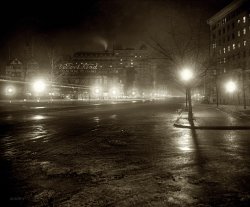
MAY CONTAIN NUTS

Search Shorpy
SHORPY ART

Framed or unframed, desk size to sofa size, printed by us in Arizona and Alabama since 2007. Explore now.
Join and Share
Ad-Free Shorpy
Shorpy is funded by you. Patreon contributors get an ad-free experience.
Learn more.

Recent comments
- Robie House Roof(s)
- There is an interesting novel set here.
- I Was In Berlin
- Pronunciation
- Shell of a Shell
- Never been there but
- BUR-lin
- Hand-made smokes
- Birthplace of Tupperware, or at least its inventor
- Pulp
- Remarkably unchanged in 84 years
- The church is still there ...
- Talk about a smoke show
- Electric Hansom Cab
- I wondered the same thing.
- The location in 2009
- Pill Pusher
- Roll your own
- Rugged and real!
- Civil War history
- Early EV?
- A Charles Purcell - Mama Cass Connection
- Uncle SAAM
- Obfuscation
- One Chocolate Soldier rode away
- Victor Marquis de la Roche
- The Little House Across Way ...
- Vanderbilt Gates
- Vanderbilt Mansion
- You can still see that gate
Member Photos
The Shorpy
Printporium
Printporium
Search Shorpy
Search results -- 30 results per page
- Hot Springs: 1900
- ... steaming water. Oh, and nice touch with the St. Nicholas Hotel there too. Just in time for Christmas!
Wide Sidewalks Fancy spas ... Posted by Dave - 08/20/2012 - 3:19pm -
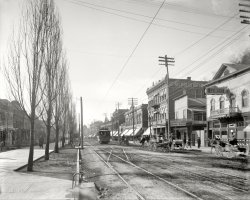
- Worth Square: 1910
- ... noted as being on the roof of the old Waldorf-Astoria hotel might possibly be related to electrical inventor Nicolai Tesla, who took ... Posted by Dave - 09/11/2015 - 11:38am -
![Worth Square: 1910 New York circa 1910. "Madison Square -- Worth Square monument at Broadway and Fifth Avenue." The Major General's obelisk, under the influence of a certain after-dinner liqueur. 8x10 inch dry plate glass negative. View full size.
Rest in TrafficUNDER THIS MONUMENT
LIES THE BODY OF
WILLIAM JENKINS WORTH
BORN IN HUDSON, N.Y.
MARCH 1, 1794
DIED IN TEXAS
MAY 7, 1849
~~~~~~~~~~~~~~
And Fort Worth Tx is named for him.
Unusual ViewIt's great to see a vintage shot of this intersection looking uptown instead of downtown. The backside of the original Waldorf-Astoria is in the middle distance, but what are the big masts with the wire between them on the roof? Wouldn't this be too early for an aerial?
[Spotting wireless telegraphy masts like this is a Shorpy tradition of long standing. Click to enlarge. -tterrace]
WorthyMajor General William Jenkins Worth (1794-1849) served heroically in the War of 1812 ,the Mexican American War and the Second Seminole War. He was in command of the Department of Texas when he died of Cholera at age 59. His remains were reinterred in this Monument.
Plastic Surgery in 1910!"Dr. Pratt Face and Features Specialist" has a suite in what I'll call the Berlitz Building. Disfigured soldiers returning from the so-called Great War increased the demand for this specialty. Some of the better practitioners were able to able to transfer their skills to movie actors.
Home RuleHmmm, I see a "HOME RULE" banner down the left-hand street. Could this have been due to Irish immigrants expressing support for self-government of their homeland?
["Home Rule" was the slogan of the Order of Acorns, an organization opposed to the Tammany Hall political machine that ran New York City government at the time. -tterrace]
CatskillIf you visit the Worth monument now, you'll notice what looks like a somber mausoleum behind it. It is a shaft of the Catskill Aqueduct, completed only seven years after the above photo was taken. I'm told there are notes written on the walls in chalk by the original contractors, and that the DEP hardly ever stops by for anything because the valve gates rusted in place many years ago and they couldn't close them if they wanted to.
Vantage pointTaken from the Flatiron Building but not, apparently, from the very top (compare the level of the balustrade on top of the building on the left in the Shorpy photo and then in the photo below).
Masts with wiresThe 'masts with wires', noted as being on the roof of the old Waldorf-Astoria hotel might possibly be related to electrical inventor Nicolai Tesla, who took up residence there in 1899.
[It's the United Wireless Telegraph Company's Waldorf-Astoria station. -tterrace]
(The Gallery, DPC, NYC, Streetcars)](https://www.shorpy.com/files/images/SHORPY-4a10553a.thumbnail.jpg)
- All Business: 1908
- ... N.W. from Treasury Dept." At right, the Ebbitt House hotel at F and 14th. 8x10 inch glass negative, Detroit Publishing Company. ... Posted by Dave - 03/07/2022 - 11:44am -
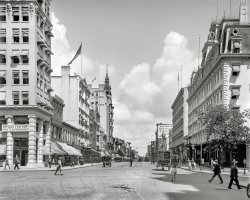
- Main Street: 1907
- ... 1907. "Main Street, Rochester, N.Y." At left, the renowned Hotel Eggleston. 8x10 inch glass negative, Detroit Publishing Company. View ... gone from the corner of Stone St. and West Main, the Hotel Eggleston has been supplanted by the modern Hyatt Regency just down the ... Posted by Dave - 11/07/2013 - 8:53am -
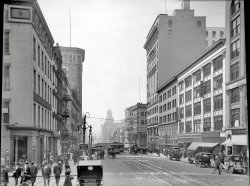
- Rubberneck Auto: 1911
- ... is arranged similarly to the tomb of Napoleon at the Hotel des Invalides in Paris. In an open crypt below the center of the dome the ... Posted by Dave - 08/01/2012 - 5:48pm -
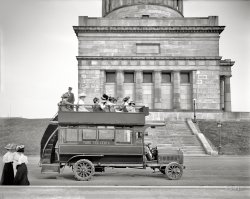
- C. City City Hall: 1942
- ... decidedly odd light poles at the entrance to the Teller Hotel have survived all these years later, although the further one in the 1942 ... Posted by Dave - 02/15/2022 - 11:54am -
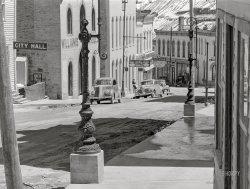
- Speed Limit 18
- ... Now you would see a parking lot for an Embassy Suites hotel. To the right is the northbound part of the 10th Street viaduct - also ... Posted by Dave - 09/10/2017 - 1:16pm -
![Speed Limit 18 November 1938. "Saloon near railroad yards. Omaha, Nebraska." Our favorite thing here is the signage: Speed Limit 18 Miles, followed closely by Cleo Cola. Photo by John Vachon for the Farm Security Administration. View full size.
Trimble BrothersGreat story about their operation in Google Books.
It's good to knowI can get cigarettes with my lunch, always a worry.
The freight depot in the backgroundWas renovated into the Harriman Dispatch Center for the UP Railroad several years ago. Quite a dramatic change from its old job description to the current state of the art facility!
This freight depot was in the background of the recent Vachon shot of the Gross Box Factory showing several dilapidated houses, and one large turkey!
The photo was taken at the intersection of 10th and Jackson Streets, looking east and a bit south. Now you would see a parking lot for an Embassy Suites hotel. To the right is the northbound part of the 10th Street viaduct - also replaced by a modern structure, but with period railings and lamp posts. At the top of the viaduct is the old Union Station, which was donated to the city by the railroad in the early 70's and is now completely restored as the Durham Western Heritage Museum.
Even though Jobber's Canyon is no more, many sister buildings still survive in the Old Market - behind Vachon's position as he took the photograph.
Knobless obligeYou've got to love the old door blocking the (open) upstairs window.
[J'adore! - Dave]
Jobber's CanyonTheodore's Place was located at 601 South 10th Street. Trimble Brothers, in the background, was a fruit and vegetable company.
This area, known as Jobber's Canyon, was all torn down to make room for the ConAgra campus in a controversial move that destroyed buildings on the historical register.
Metz BrothersThe "MB" in the architectural decoration is for "Metz Brothers," a prominent Omaha brewer. They received a permit in 1897 to construct a two story building at 601 South Tenth Street.
Named after a cigarIn 1935, the Whistle Cola Company introduced Cleo Cola, named after the owner's favorite cigar and featured Cleopatra as a trademark. Cleo Cola advertising is classic soda pop memorabilia and is very sought after by collectors.
Make that 13Just a small detail, but there is not even a shadow of left side loops on the second numeral. But there are three definite beginnings of the points of a 3. Either way, 13 or 18, it's a strange speed limit.
[You may need a new monitor or screen. -tterrace]
Yes Termite, your new 3x5 clip clearly shows 18. But with the original Jumbo-Tron photo, it was clearly an unclear Thirteen! :>)
Wormy
[It's not a "new clip;" it's cropped from a direct, unaltered screenshot of the "View full size" that's been there since the initial posting. -tterrace]
A very belated apology. I never really thought that you would alter an image.
Best regards T.T.
Wormy
(The Gallery, Eateries & Bars, John Vachon, Omaha, Railroads)](https://www.shorpy.com/files/images/SHORPY-8b14222a.thumbnail.jpg)
- Miami Monochrome: 1910
- ... on the right -- that's Miami Beach or Key Biscayne. A hotel or two there now, I hear. - Dave]
Let's get our shovels and ... Posted by Dave - 08/14/2012 - 6:55pm -
![Miami Monochrome: 1910 Miami, Florida, circa 1910. "Biscayne Bay through the cocoanut trees." 8x10 inch dry plate glass negative, Detroit Publishing Company. View full size.
Inspirational Makes me want to try and find my old ukulele and sing. "We used to gather in the moonlight on old Biscayne Bay." Well, actually it's Honolulu Bay in the song, but this bay will do nicely.
The Big WAll I could think of is the palm tree scene from "It's a Mad Mad Mad Mad World."
Behind the big tree on the leftAren't those the Marx Brothers?
AhhhhThis looks soooo peaceful. I can almost feel the warm breeze. Where's the hunky pool boy with a Mai Tai for me?
DifferencesOther than the boats, is this view that much different than today?
[The island in the distance on the right -- that's Miami Beach or Key Biscayne. A hotel or two there now, I hear. - Dave]
Let's get our shovels and start diggingI can actually see the Big W!
(The Gallery, DPC, Florida, Miami)](https://www.shorpy.com/files/images/4a25105a.thumbnail.jpg)
- Rooftops of Washington: 1901
- ... Street N.W., between B & C Streets, probably from Hotel Engel (C & New Jersey), showing rooftops of several buildings and ... high This is indeed the view SSE from the roof of the Hotel Engel at Indiana Avenue (aka C Street) & New Jersey Avenue NW. That's ... Posted by Dave - 02/06/2021 - 10:03am -
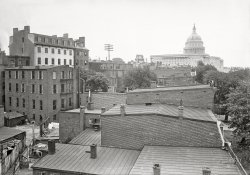
- By the Sea: 1908
- The Jersey Shore circa 1908. "Marlborough-Blenheim hotel and Boardwalk, Atlantic City." 8x10 inch dry plate glass negative. View ... back in the late 19th and up until after WWII, this hotel and the neighboring Traymore were synonymous with luxe accommodations. ... Posted by Dave - 04/29/2016 - 2:09pm -
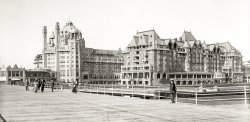
- K.C. Club: 1906
- ... It was demolished shortly thereafter and replaced by the "Hotel Stats" -- and no, that's not a typo.
(The Gallery, DPC, Streetcars) ... Posted by Dave - 05/25/2022 - 2:10pm -
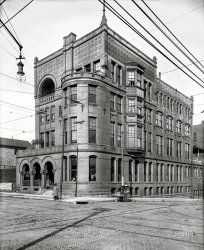
- Flour Power: 1908
- ... Mill and the boiler house - were restored for office and hotel uses in the mid-1980s with an influx of cash from Silicon Valley investor ... Posted by Dave - 08/15/2014 - 8:51am -
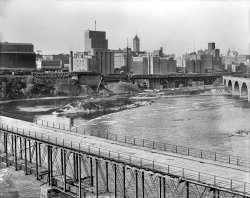
- The Continental: 1902
- 1902. "Hotel Continental -- Atlantic Beach, Florida." Henry Flagler's massive ... FloridaMemory.com, "Golf links and palm trees, Continental Hotel - Atlantic Beach, Florida". Postcard postmarked July 1 1906. The beach is ... Posted by Dave - 05/17/2014 - 11:35pm -
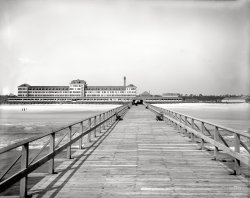
- Magic Kingdom: 1902
- "Tampa Bay Hotel, Florida, 1902." 8x10 inch dry plate glass negative by William Henry ... Posted by Dave - 07/17/2012 - 10:36pm -
![Magic Kingdom: 1902 "Tampa Bay Hotel, Florida, 1902." 8x10 inch dry plate glass negative by William Henry Jackson, Detroit Publishing Company. View full size.
Nah - can't be!Is that a one horsepower riding lawn mower on the left?
[Could be!]
Wow - and one can fertilize the grass at the same time!
Now Plant HallNow known as Plant Hall, home of the Henry B. Plant Museum on the University of Tampa campus.
Up for debateA timely location tonight.
Maintenence HeadacheI remember over the years the minarets were always a maintenence problem. It seemed they were always scraping and painting on them. Finally several years ago they gave up and put on new metal skins, similar to what they did to the Statue of Liberty I guess.
Satellite Dishes?Anyone know what the satellite dish-shaped gizmos on the upper-right corner balcony area are? Lightning related?
[They're still there today, doing their silent duty. Which is purely decorative.]
Cool, I had never noticed those things before. I guess the picture is more hi-res than a real life visit.
(The Gallery, DPC, Florida, W.H. Jackson)](https://www.shorpy.com/files/images/SHORPY_4a16830a.thumbnail.jpg)
- Petro-Palace: 1922
- ... is the corner now View Larger Map
The hotel later built behind the station and opening in 1925 is the Mayflower, ... Posted by Dave - 04/24/2013 - 3:25pm -
![Petro-Palace: 1922 Washington, D.C., circa 1922. "Gas station, 17th and L streets N.W." The recently opened Washington Accessories filling station, also seen here under construction, three years later as Minute Service No. 1 and finally around 1928. National Photo Company Collection glass negative. View full size.
Six Pumps in 1922!Wow! You can tell the center of government had plenty of autos running around, even back then! In most of the country back then, there would be one pump out front of a grocery store or small service station. This place was a contemporary gas/convenience store 80 years ahead of its time.
This is the corner nowView Larger Map
The hotel later built behind the station and opening in 1925 is the Mayflower, still operating as the Mayflower Renaissance and owned by the Marriott Corporation. The dome at center in the 1922 photo is the Cathedral of St. Matthew the Apostle located at 1725 Rhode Island Ave. NW.
Defunct tire companiesHood Tires were from the Hood Rubber Company of Watertown, Massachusetts. The company began operations way back in 1896, although tire production may not have started until sometime later. Many of the Armenian immigrants who formed a still-extant community in Watertown worked at the company's huge manufacturing complex. B.F. Goodrich acquired the company in the late 1920's and phased out the brand name. The Watertown plant remained in operations as a Goodrich facility, albeit one that made footwear rather than tires, until it closed in 1969.
Founded in 1905, the Ajax-Grieb Rubber Company of New York manufactured Ajax tires in Trenton, New Jersey and Racine, Wisconsin. The company struggled through the 1920's, and in a last-ditch attempt to cut costs it closed the Trenton facility in 1928. In 1931 Ajax-Grieb became one of the many companies that could not survive the Great Depression and went out of business for good.
Still neededThose nifty metal policeman directional signs of "in" and "out" would be useful even in today's gas stations since it seems no matter how many pumps or how large or small the station, there is always one or two drivers who enter the wrong way and mess up everyone else. This also happens at "all-you-can-eat" buffets where you can bet that one or two plate fillers will be going against the grain, coming at you head-on. I suppose that is why cattle are always herded into narrow pathways that are one direction only.
17th and LThere's the dome of St. Matthew's Cathedral in the background.
Standard Oil New JerseyJudging by the globes on the gas pumps it is a pre-Esso Standard Oil of New Jersey station.
Was there a Minute Service No. 2for cars that had their gas filler on the driver side? Or were the hoses on those pumps long enough (unlike the ones of today) to reach the "other" side of cars that were forced to enter the "wrong way" by the cutesy signs?
High Gas PricesIs the Lightning Motor Fuel sign, behind the bushes, advertising a gas price of 31 cents? If so, gas was more expensive than I thought in those days.
I see the oil sign of 31 cents per quart.
Convex-bottom bucketsI have seen those convex-bottom buckets in lumber yards, intended for fire extinguishing service. Are they employed here for radiator service, or for conflagrations?
[Fires. Below, a listing in an 1896 tool catalog. -tterrace]
(The Gallery, D.C., Gas Stations, Natl Photo)](https://www.shorpy.com/files/images/SHORPY_30288u.thumbnail.jpg)
- Up Broadway: 1901
- ... (designed by Henry J. Hardenbergh, architect of the Plaza Hotel and many other buildings). The Western Union was demolished in 1913 to ... Posted by Dave - 08/09/2012 - 6:11pm -
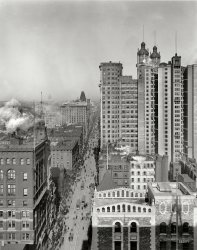
- Window Shopping: 1943
- ... The photo reminds me of my two years spent at the Barbizon Hotel for Women in NYC. Every few months our so, the staff changed out our ... Posted by Dave - 05/25/2016 - 12:40pm -
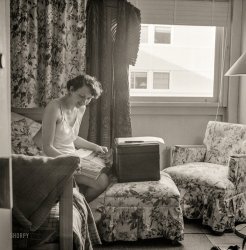
- Do Not Touch: 1910
- ... southeast Nebraska town in the early 1960s to run a hotel . That town had its own municipal telephone company. Every phone in town had a 3-digit number - our hotel had two lines, 117 and 118. To place a call, one lifted the receiver and ... Posted by Dave - 01/31/2014 - 5:29pm -
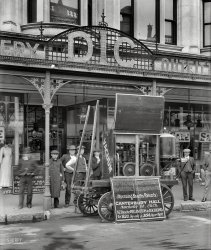
- Pike's Peak or Bust: 1937
- ... Pierce-Arrows at Altitude For many years, the Broadmoor Hotel in Colorado Springs maintained a fleet of Pierce-Arrows (first modified ... Posted by RDown3657 - 12/15/2014 - 8:44pm -
![Pike's Peak or Bust: 1937 Taken near Pike's Peak, Colorado, my great grandfather's brother, George W. Downing, poses with his wife, family, and one great automobile. View full size.
No ApostropheIn 1891, the US Board on Geographic Names recommended against the use of apostrophes, and in 1978 the Colorado state legislature passed a law requiring the use of Pikes Peak. However there are still 5 places in the States with apostrophes in their name.
[Zebulon Pike would probably have something to say about that. - Dave]
Nice hood ornamentWhat a great idea to make the car's hood ornament in the shape of a man with a straw hat!
Faded LuxuryA well worn 1929 Cadillac and a circa 1925 Pierce Arrow, at the rear
High Noonremarked Captain Obvious.
Roll-back RoofI've never seen a car roof like that: it's obvious that it can be rolled back, or closed using the prongs around its periphery, but is that factory standard or custom?
[This appears to be a tourist service in operation, providing sightseeing tours in the old 7-9 passenger sedan as well as a souvenir photo. As we've seen recently, solid metal car roofs hadn't arrived yet, but to me this adaptation has a rather do-it-yourself look to it. -tterrace]
Cars on Pikes PeakI remember being driven up Pikes Peak in 1960 in a 1953 Cadillac fitted with a specially fitted low-geared 3-speed transmission. We ground up to the top because my mother did not want to drive our 1956 Pontiac, loaded with me, my two sisters, my aunt, and my cousin, up there. I remember some concern as to the cost, but I (at 12) thought the Cadillac option was really neat.
Pierce-Arrows at AltitudeFor many years, the Broadmoor Hotel in Colorado Springs maintained a fleet of Pierce-Arrows (first modified limousines, then buses) for just such touristic service. Those were later replaced by a number of stretch Cadillacs, some with Plexiglas roofs.
Having driven the route a number of times, I must say that the dirt portions could be challenging, and when most of the route was unpaved, such buses and limos must have seemed an attractive alternative to the private car to drivers from the flatlands ... and to their potential passengers as well.
1928 Faded LuxuryThe Cadillac is actually a 1928 model. The parking lights mounted on the cowl are the primary detail that instantly differentiates it from the following year. In 1929 these lights were scaled-down and moved to the top of the front fenders.
The Cadillac shown looks like the Custom Fleetwood Imperial for Five Passengers. The molding above the windows that ends abruptly just after the rearmost window is not seen on the regular Five-Passenger Imperial. The Custom Fleetwood version was more luxuriously appointed including satin-inlaid hardware which was two-tone gold with bright edging. There were two occasional seats in the rear compartment. The Custom Fleetwood cost $4,245 while the Five-Passenger Imperial was $50 less.
Cadillac offered more than 50 body styles in 1928 along with over 500 color combinations. The marque's luxury image was enhanced by eliminating both the 132 and 138 inch wheelbases and standardizing on one of 140 inches. The V-8 engine was tweaked, and it now produced 90 horsepower (up from 87). Cadillac manufactured 56,038 automobiles in 1928 - including 16,038 LaSalles. It would be their best year of production until 1941.
Outfits?What are those matching outfits with the flared legs? They look like a cross between a cowboy costume and a basketball warm-up suit.
[Here's some women's casual wear of the 1930s. -tterrace]
Maybe a "cool down" location for the Cadillac I lived in Colorado Springs for 5 years and drove up the peak annually. Being that the picture was taken at just over 11,000' they have already climbed roughly 4,000' from Manitou Springs, and they have another 3,000' to go to reach the summit.
I note that the engine cowling is raised and I suspect this was probably a planned stop to aid in keeping the engine cool on the way up.
As an aside, I found the trip up to the summit of Mount Evans near Idaho Springs a more exciting climb! It is advertised as the highest paved road in North America.
The road was built to directly compete with Pikes Peak for tourist dollars. It is not an accident that the parking area of Mt Evans is 20' higher than the Pikes Peak Summit. The peak summits are within 150' in height of each other, but Mt Evans is slightly taller.
"At the turn of the last century, Colorado Springs and Denver were in a race for the hearts and minds (not to mention dollars) of the eastern tourist. In 1888, the Cascade and Pikes Peak Toll Road Company completed a 16-mile road up the north side of Pikes Peak. This became a major tourist attraction, drawing tourists away from Denver Area. Not to be outdone, Denver's Mayor Peer proposed that a road be constructed to the top of Mount Evans. In 1917, he procured state funds to build the road. It was completed in 1927."
(ShorpyBlog, Member Gallery)](https://www.shorpy.com/files/images/1down.thumbnail.jpg)
- Where the Dolls Loll: 1922
- ... runs dry -- that new swimming pool at the Wardman Park Hotel in Washington. National Photo Company Collection glass negative. View ... Posted by Dave - 09/13/2011 - 11:59am -
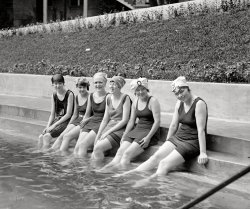
- Elko Depot: 1940
- ... But the Nevada Bank Building remains. The Commercial Hotel is now the Commercial Casino.
"An Outpost of Hell, or ...
I remember the hot dogs at the cafe at the Commercial Hotel, split, fried, and served on a hamburger bun. The drug store whose sign ... Posted by Dave - 02/20/2018 - 11:01am -
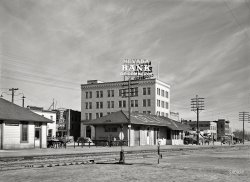
- Work, Read, Wash: 1943
- ... floor length fixtures many years ago in a historic hotel, I believe in Wellsville W.Va, or thereabouts. Not just similar, but ... not stay. I looked on Google Earth and didn't find the hotel, may not have survived. At the time, it was in the guidebook of historic ... Posted by Dave - 07/29/2016 - 8:13pm -
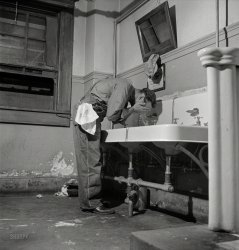
- The Pewmobile: 1918
- ... which makes fixed loading platforms feasible. A resort hotel might have a vehicle like this.
If some well-equipped Shorpy Sleuth ... Posted by Dave - 04/12/2017 - 7:07am -
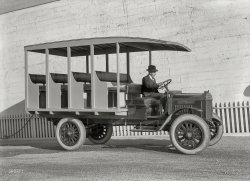
- No Horseplay: 1923
- June 26, 1923. Back at the Wardman Park Hotel in Washington, D.C. Taken a year after the pool's opening in 1922 , ... Posted by Dave - 09/13/2011 - 12:01pm -
![No Horseplay: 1923 June 26, 1923. Back at the Wardman Park Hotel in Washington, D.C. Taken a year after the pool's opening in 1922, this photo shows the addition of a slide. National Photo Company Collection glass negative. View full size.
That slide is really steepI imagine coming down that slide would be quite a rush.
It really reminds me of the (long-gone) slide at the hot springs pool in Glenwood Springs, Colorado. As a child in the 70's who could hardly swim, I made the regrettable decision to try it out with the big kids and grownups. It shot me straight into the middle of the pool, in all of my arm-thrashing, snotty-nosed, "Daddy, help! Come save me!" glory. So embarrassing looking back on it now.
Stay FocusedRight hand side of the picture, almost half way up. Is that boy really wearing glasses while swimming?
Unfair!As a child in the 1940's I always wondered why girls were required to wear bathing caps in pools, while boys never were. And many of us had hair pretty much the same length. Sometime in the 60's (I think) bathing caps were no longer required.
SpecsThat kid on the right looks like he has his ordinary glasses on. Either that or swimming goggles were invented a lot earlier than I suspected.
Spectacular SwimmerI wear my glasses in the pool. And am fortunate to live in a time when swimsuits are no longer made of 100 percent wool.
TopsWell, good, I'm relieved to see we're on the topic of recreational aquatic attire, because I was wanting to ask what men's tops were supposed to be covering in this era. Why were they worn? And were the tops age-specific, like did the youngest boys go topless but older boys on up wore tops? Or was it more of a cultural thing — city males wore them, country males didn't? It just seems like an odd accessory given what I perceive as the acceptance of skinny-dipping in rural swimming holes in this general time frame.
(Sure, I could go to Google for answers to these questions, but I trust Shorpy readers more.)
[Men's tops were de rigueur at Washington's coed pools and bathing beaches in the 1920s. - Dave]
(The Gallery, D.C., Natl Photo, Sports, Swimming)](https://www.shorpy.com/files/images/09005u.thumbnail.jpg)
- Bellevue-Stratford: 1905
- Philadelphia circa 1905. "The Bellevue-Stratford Hotel." As is often the case in these architectural views, the most interesting ... Posted by Dave - 07/19/2012 - 12:59pm -
![Bellevue-Stratford: 1905 Philadelphia circa 1905. "The Bellevue-Stratford Hotel." As is often the case in these architectural views, the most interesting bits are at the periphery. 8x10 inch dry plate glass negative, Detroit Publishing Company. View full size.
LegionnairesThe home of Legionnaires' disease.
Lions and Tigers and Gargoyles, oh my!One of the best pics of a 19-story building I've seen on Shorpy.
MemoriesThis photo brings back memories. I stayed at the Bellvue-Stratford during the Bicentennial celebrations of 1976 and had a wonderful time. The following week is when they had the outbreak of Legionnaires' disease.
A QuestionWhat was in the attics of these ornately-roofed buildings? Some utilities, I imagine, but were all those windows and balconies and railings there for apartments, servants' quarters, offices, or just trim fronting unfinished space?
IXThe 19th floor is now a pretty cool bar. You can sit on those century old balconies.
[If it was in ancient Rome, you'd have to walk up the rest of the ten floors. 19 = XIX. -tterrace]
(The Gallery, DPC, Philadelphia, Streetcars)](https://www.shorpy.com/files/images/SHORPY_4a12593a.thumbnail.jpg)
- Grand Rapids: 1908
- ... and Monroe Center.
The building on the left is Sweet's Hotel, on the site of the Pantlind (now Amway Grand Plaza) Hotel built in 1913.
(The Gallery, DPC, Stores & Markets) ... Posted by Dave - 05/17/2014 - 11:34pm -
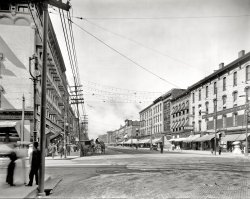
- Mint Condition: 1958
- ... year-old in San Francisco.
Newsworthy location The Hotel Chronicle next door was named for the San Francisco Chronicle newspaper, ...
Pickwick Stages To the right is the Pickwick Hotel, once the station for Pickwick Stages buses. If the picture included a ... Posted by Dave - 06/07/2014 - 10:15am -
![Mint Condition: 1958 August 1958. "U.S. Branch Mint, Mission & Fifth Streets, San Francisco." Photo by William S. Ricco for the Historic American Buildings Survey. View full size.
Worth a mintNice to see the home of all the "-S" coins from my childhood coin collection.
[This facility stopped minting coins in 1937; thereafter "S" mint-marked coins were produced at the new mint at Market and Duboce Streets. -tterrace]
Ah, OK thanks! (That would explain why it was being recorded for a survey of historic buildings ...)
Nary a trolleybus in sightIt's kind of hard to tell though, for all the trolleybus wires in the way. Ferry Plaza route 14 is a currently served by the new generation trolleybuses though.
Old Mint History ExpoThe Old Mint is the venue for the annual San Francisco History Expo, at which "more than fifty San Francisco organizations create 'mini-museums' showcasing the diverse history of San Francisco's communities." Here's a shot I took at the one in March 2013, right up there at the top of the entrance steps. Also, I knew this man who worked there at the time of the 1906 earthquake and fire.
FostersFosters had restaurants in a few locales in San Francisco. My parents and I used to go to the outlet on Clement Street after doctor appointments. I amused myself at King Norman's Kingdom of Toys, the corner magazine and news store and eventually enjoying a rice pudding at Fosters. 1958 was a nice year for an eight year-old in San Francisco.
Newsworthy locationThe Hotel Chronicle next door was named for the San Francisco Chronicle newspaper, which is on the other side of the intersection. On the right side of the photo, you can see a delivery vehicle loaded with the day's newspapers.
[You're right about the location of the Chronicle building, but those aren't newspapers. Also, the Chronicle used delivery vans. -tterrace]
Ultra RareEven for then, in the immediate left foreground by the bus is another of those 1950 eight passenger Chryslers, identified by its center opening rear doors and separate rear quarter windows. Made in every trim level except surprisingly New Yorker, it looks like the shorter wheelbase (125") Royal or Windsor rather than the extended wheelbase (145") Crown Imperial.
Pickwick StagesTo the right is the Pickwick Hotel, once the station for Pickwick Stages buses. If the picture included a bit more to the right, you would notice the big arched sections where the buses once pulled in to load and discharge passengers.
Dash Hammett had Sam Spade check the Maltese Falcon at the Pickwick baggage room...
(The Gallery, Cars, Trucks, Buses, HABS, San Francisco)](https://www.shorpy.com/files/images/SHORPY-016866pu.thumbnail.jpg)
- Post Office Restaurant: 1901
- ... the New Post Office. Also known as the Trump International Hotel. - Dave]
Tracing a Structure's Pedigree Take the third ... Posted by Dave - 10/10/2020 - 7:31pm -
![Post Office Restaurant: 1901 Washington, D.C., circa 1901. "View of D Street N.W., looking west from 12th Street at Pennsylvania Avenue." 5x7 inch glass negative, D.C. Street Survey Collection. View full size.
Hints of ParisThat corner building would look at home in Montmartre.
Back When It Really Was the Post OfficeI'm going to take a flyer here and guess that the restaurant has that name because it is across the street (or at least very near) to the Old Post Office, which is at Pennsylvania and 12th.
[Which at the time would have been the New Post Office. Also known as the Trump International Hotel. - Dave]
Tracing a Structure's PedigreeTake the third building down the street — the one with the large flagpole atop it. As the son of a DC firefighter, I recognized it right away as bearing the unmistakable signature façade of a fire station: driveway with flanking lamps, huge arched front doors, sidewalk chair, and the flagpole. With the help of an 1888 Sanborn Fire Insurance map, I can confirm that this (1204 D St. NW) was indeed the home of DCFD Engine Company 2 up until 1887. At the time this photo was taken circa 1901, Engine 2 had moved to other quarters but the building’s pedigree is still readily evident. More about Engine 2’s history here.
What I wouldn’t give to have been standing in the photographer’s position just a few years prior to when this photo was composed to witness Engine 2, a classic Amoskeag 600 GPM steamer pulled by horses, emerge in all its smoking, gleaming glory and responding to an alarm.
All day breakfastI'll have coffee, three poached eggs on a plate of hash-browns, whole wheat, topped with a roll of "forever stamps", please.
Congress BeerThe Abner-Drury Brewery was in the Foggy Bottom neighborhood of Washington. After Prohibition was repealed the first legal bottle of beer produced by the brewery was delivered to President Roosevelt at the White House on April 14, 1933.
(The Gallery, D.C., D.C. Street Survey, Eateries & Bars)](https://www.shorpy.com/files/images/SHORPY-40252a.thumbnail.jpg)
- New York Squared: 1903
- ... newspaper building, Sixth Avenue elevated tracks and Hotel Astor. 8x10 inch glass negative, Detroit Publishing Company. View full ... Posted by Dave - 09/21/2014 - 12:31pm -
![New York Squared: 1903 Circa 1903. "Herald Square, New York." With Times Square in the distance, and the New York Times building going up at center. Other landmarks include Macy's, the New York Herald newspaper building, Sixth Avenue elevated tracks and Hotel Astor. 8x10 inch glass negative, Detroit Publishing Company. View full size.
What's the point of wearing PearlsIf no one can detect them?
Absolutely FireproofThanks to our asbestos carpets and bed linens.
As was the popular styleLots of swells in Herald Square on this fine day.
Time and - temperature?Try as I might, the internets did not reveal what the dial on the right of the Herald building indicates. However, stories of Minerva, the owls, and 'Guff n Stuff' the bell ringers abound. None of the photos I found were any more detailed than this one, but perhaps it was a thermometer?
[The answer is here, courtesy Shorpy. -tterrace]
Next StopThe next stop on the Northbound 6th Ave EL appears to be 38th Street However after I Wiki'd it, I have decided that that it was 42nd St as the 38th Street Station didn't open until 1913. That fabled line was torn down around 1940 and the steel was supposed to have been sold to the Japanese.
Watch out!The 1903 equivalent of texting while walking. Reading while walking.
Cable carsHow long did they have a cable car system? I had never heard of it before.
[There were no longer any cable trolleys in Manhattan at this time. The center slot provides access to an electrical conduit. -tterrace]
(The Gallery, DPC, NYC, Railroads, Streetcars)](https://www.shorpy.com/files/images/SHORPY-4a11541a.thumbnail.jpg)
- Washington Noir: 1926
- ... The tall building on the north side of Pennsylvania is the Hotel Raleigh, which along with the Willard Hotel (behind the camera) was designed by Henry J. Hardenbergh. Built in 1911 ... Posted by Dave - 07/17/2012 - 10:14pm -
